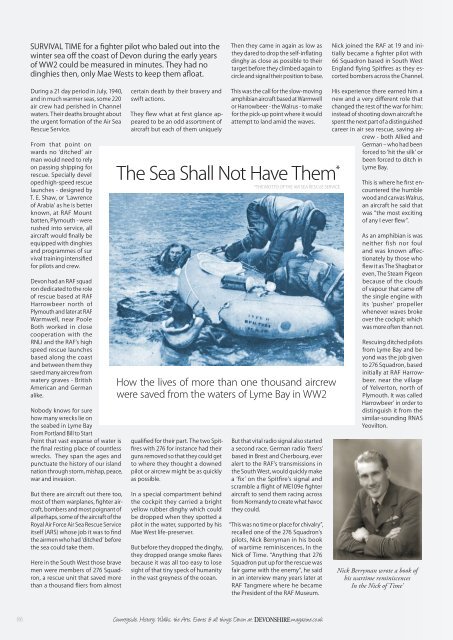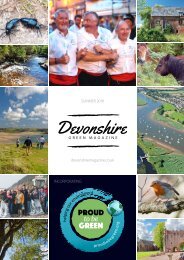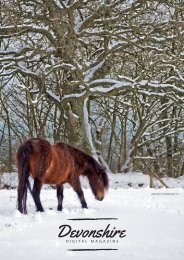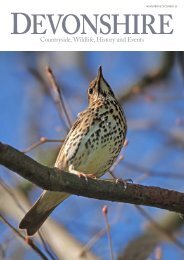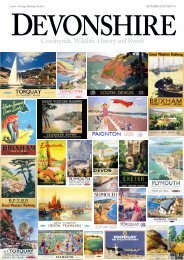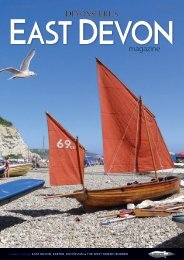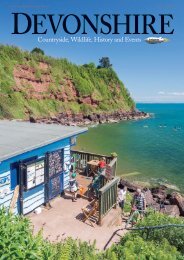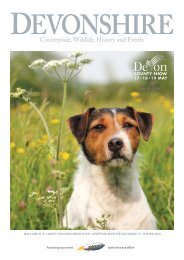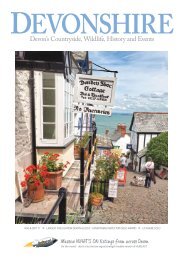Devonshire June July 16
Everything Devon: Countryside, Wildlife, History, Events, Music
Everything Devon: Countryside, Wildlife, History, Events, Music
Create successful ePaper yourself
Turn your PDF publications into a flip-book with our unique Google optimized e-Paper software.
SURVIVAL TIME for a fighter pilot who baled out into the<br />
winter sea off the coast of Devon during the early years<br />
of WW2 could be measured in minutes. They had no<br />
dinghies then, only Mae Wests to keep them afloat.<br />
Then they came in again as low as<br />
they dared to drop the self-inflating<br />
dinghy as close as possible to their<br />
target before they climbed again to<br />
circle and signal their position to base.<br />
Nick joined the RAF at 19 and initially<br />
became a fighter pilot with<br />
66 Squadron based in South West<br />
England flying Spitfires as they escorted<br />
bombers across the Channel.<br />
During a 21 day period in <strong>July</strong>, 1940,<br />
and in much warmer seas, some 220<br />
air crew had perished in Channel<br />
waters. Their deaths brought about<br />
the urgent formation of the Air Sea<br />
Rescue Service.<br />
From that point onwards<br />
no ‘ditched’ airman<br />
would need to rely<br />
on passing shipping for<br />
rescue. Specially developed<br />
high-speed rescue<br />
launches - designed by<br />
T. E. Shaw, or ‘Lawrence<br />
of Arabia’ as he is better<br />
known, at RAF Mountbatten,<br />
Plymouth - were<br />
rushed into service, all<br />
aircraft would finally be<br />
equipped with dinghies<br />
and programmes of survival<br />
training intensified<br />
for pilots and crew.<br />
Devon had an RAF squadron<br />
dedicated to the role<br />
of rescue based at RAF<br />
Harrowbeer north of<br />
Plymouth and later at RAF<br />
Warmwell, near Poole.<br />
Both worked in close<br />
cooperation with the<br />
RNLI and the RAF’s high<br />
speed rescue launches<br />
based along the coast<br />
and between them they<br />
saved many aircrew from<br />
watery graves - British,<br />
American and German<br />
alike.<br />
Nobody knows for sure<br />
how many wrecks lie on<br />
the seabed in Lyme Bay.<br />
From Portland Bill to Start<br />
Point that vast expanse of water is<br />
the final resting place of countless<br />
wrecks. They span the ages and<br />
punctuate the history of our island<br />
nation through storm, mishap, peace,<br />
war and invasion.<br />
But there are aircraft out there too,<br />
most of them warplanes, fighter aircraft,<br />
bombers and most poignant of<br />
all perhaps, some of the aircraft of the<br />
Royal Air Force Air Sea Rescue Service<br />
itself (ARS) whose job it was to find<br />
the airmen who had ‘ditched’ before<br />
the sea could take them.<br />
Here in the South West those brave<br />
men were members of 276 Squadron,<br />
a rescue unit that saved more<br />
than a thousand fliers from almost<br />
certain death by their bravery and<br />
swift actions.<br />
They flew what at first glance appeared<br />
to be an odd assortment of<br />
aircraft but each of them uniquely<br />
qualified for their part. The two Spitfires<br />
with 276 for instance had their<br />
guns removed so that they could get<br />
to where they thought a downed<br />
pilot or aircrew might be as quickly<br />
as possible.<br />
In a special compartment behind<br />
the cockpit they carried a bright<br />
yellow rubber dinghy which could<br />
be dropped when they spotted a<br />
pilot in the water, supported by his<br />
Mae West life-preserver.<br />
But before they dropped the dinghy,<br />
they dropped orange smoke flares<br />
because it was all too easy to lose<br />
sight of that tiny speck of humanity<br />
in the vast greyness of the ocean.<br />
This was the call for the slow-moving<br />
amphibian aircraft based at Warmwell<br />
or Harrowbeer - the Walrus - to make<br />
for the pick-up point where it would<br />
attempt to land amid the waves.<br />
The Sea Shall Not Have Them *<br />
*THE MOTTO OFTHE AIR SEA RESCUE SERVICE<br />
How the lives of more than one thousand aircrew<br />
were saved from the waters of Lyme Bay in WW2<br />
But that vital radio signal also started<br />
a second race. German radio ‘fixers’<br />
based in Brest and Cherbourg, ever<br />
alert to the RAF’s transmissions in<br />
the South West, would quickly make<br />
a ‘fix’ on the Spitfire’s signal and<br />
scramble a flight of ME109e fighter<br />
aircraft to send them racing across<br />
from Normandy to create what havoc<br />
they could.<br />
“This was no time or place for chivalry”,<br />
recalled one of the 276 Squadron’s<br />
pilots, Nick Berryman in his book<br />
of wartime reminiscences, In the<br />
Nick of Time. “Anything that 276<br />
Squadron put up for the rescue was<br />
fair game with the enemy”, he said<br />
in an interview many years later at<br />
RAF Tangmere where he became<br />
the President of the RAF Museum.<br />
His experience there earned him a<br />
new and a very different role that<br />
changed the rest of the war for him:<br />
instead of shooting down aircraft he<br />
spent the next part of a distinguished<br />
career in air sea rescue, saving aircrew<br />
- both Allied and<br />
German ‒ who had been<br />
forced to ‘hit the silk’ or<br />
been forced to ditch in<br />
Lyme Bay.<br />
This is where he first encountered<br />
the humble<br />
wood and canvas Walrus,<br />
an aircraft he said that<br />
was “the most exciting<br />
of any I ever flew”.<br />
As an amphibian is was<br />
neither fish nor foul<br />
and was known affectionately<br />
by those who<br />
flew it as The Shagbat or<br />
even, The Steam Pigeon<br />
because of the clouds<br />
of vapour that came off<br />
the single engine with<br />
its ‘pusher’ propeller<br />
whenever waves broke<br />
over the cockpit: which<br />
was more often than not.<br />
Rescuing ditched pilots<br />
from Lyme Bay and beyond<br />
was the job given<br />
to 276 Squadron, based<br />
initially at RAF Harrowbeer.<br />
near the village<br />
of Yelverton, north of<br />
Plymouth. It was called<br />
‘Harrowbeer’ in order to<br />
distinguish it from the<br />
similar-sounding RNAS<br />
Yeovilton.<br />
Nick Berryman wrote a book of<br />
his wartime reminiscences<br />
In the Nick of Time'<br />
86<br />
Countryside, History, Walks, the Arts, Events & all things Devon at: DEVONSHIRE magazine.co.uk


